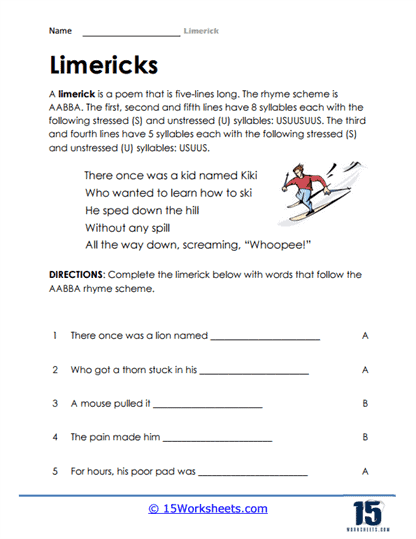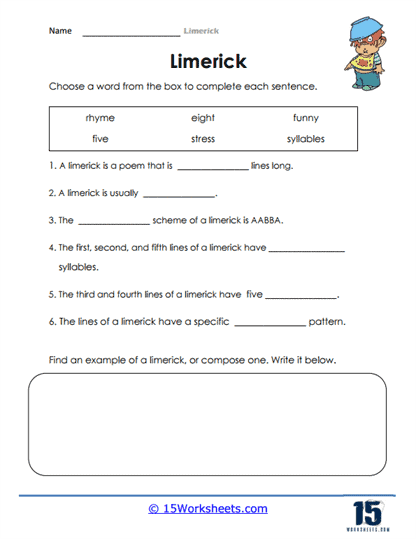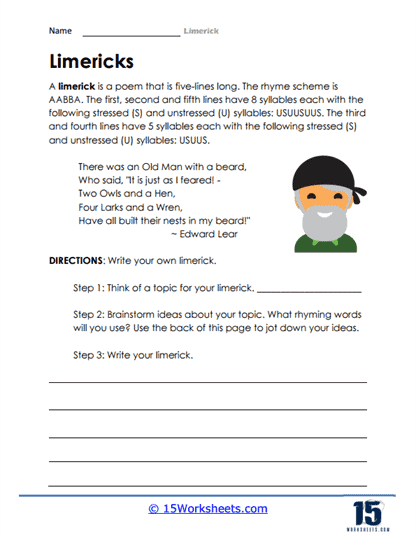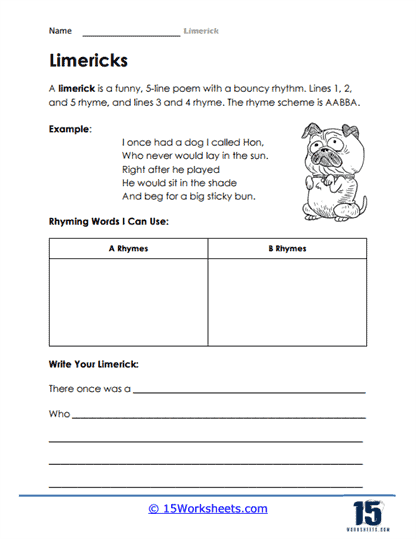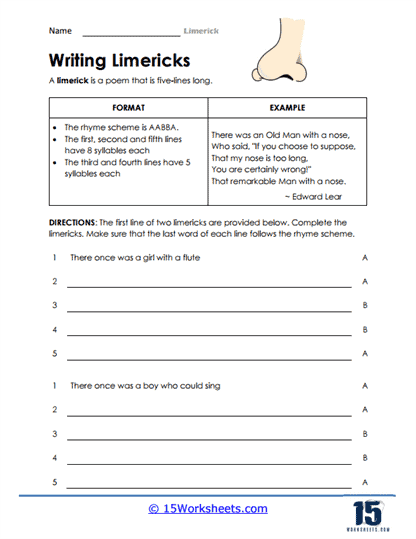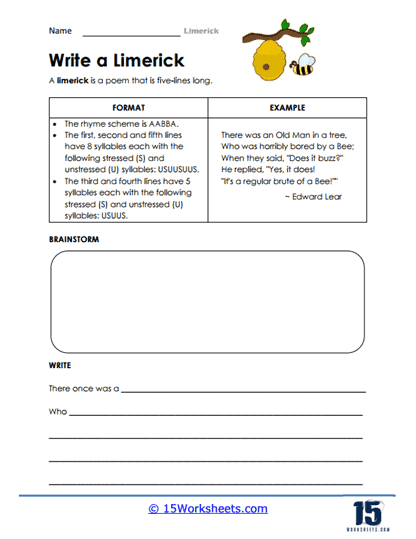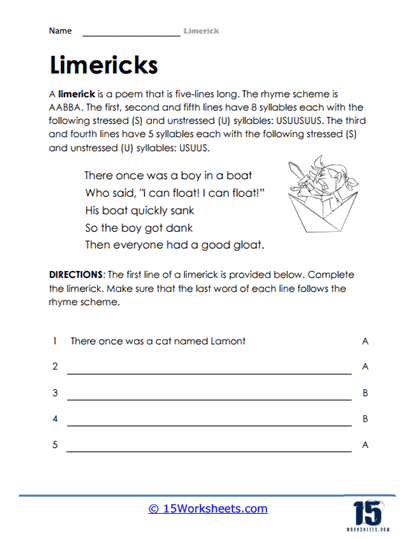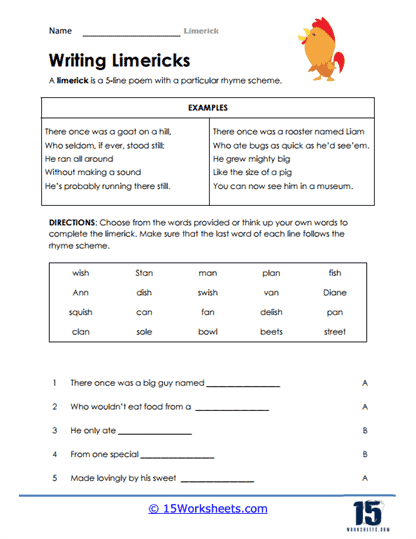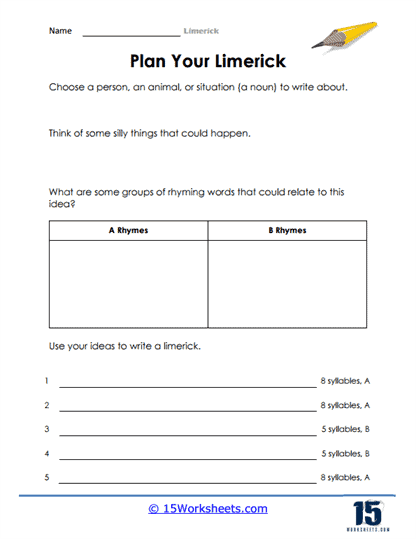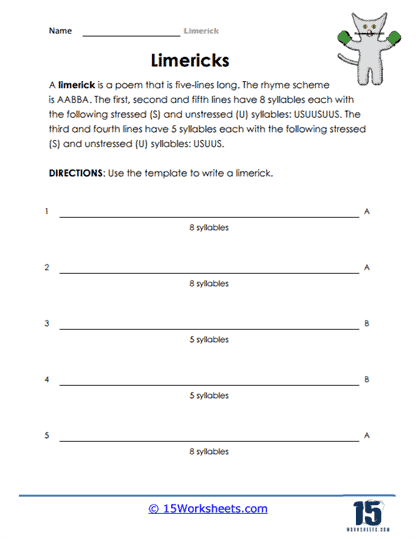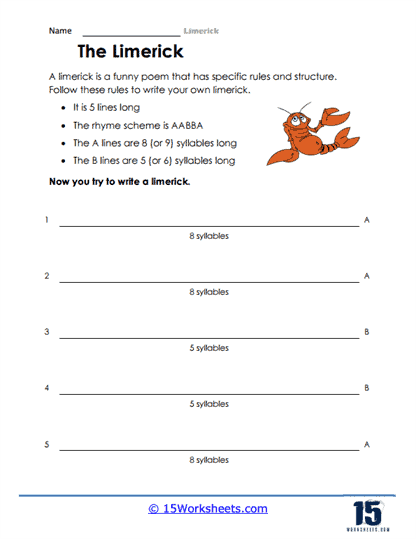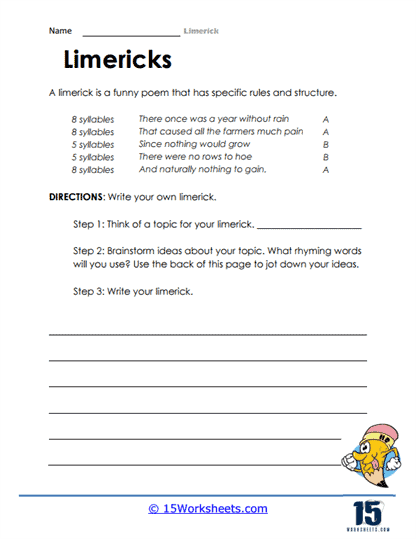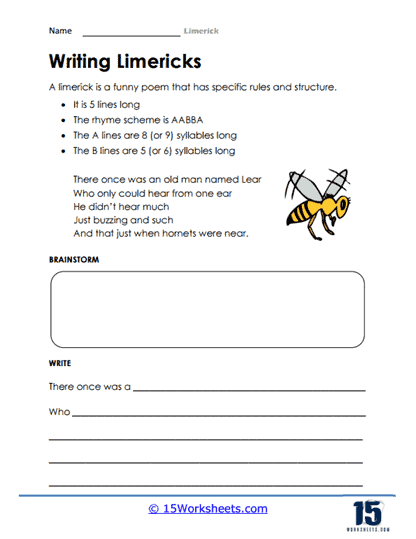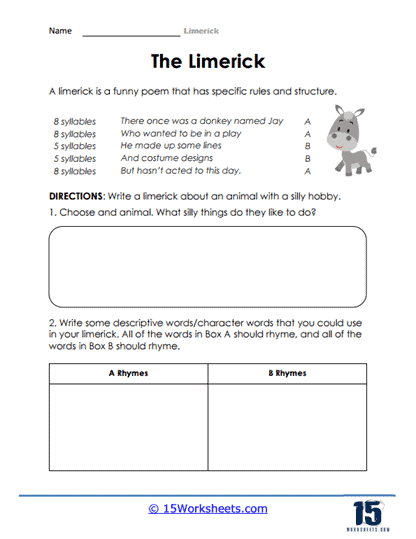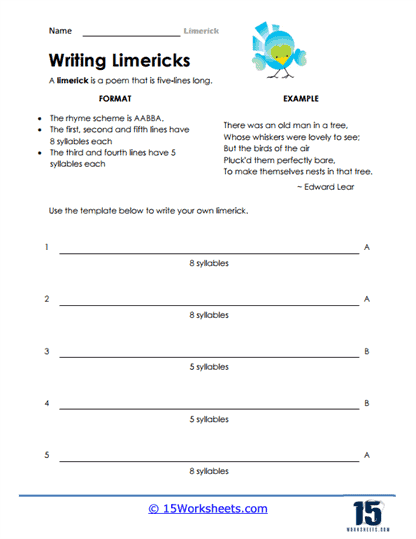Limerick Worksheets
All About These 15 Worksheets
Limericks, a unique and playful form of poetry characterized by their humorous and often absurd themes, are a delightful entry point into the world of poetry. Understanding limericks not only sparks students’ creativity but also helps them appreciate the art of wordplay, rhythm, and storytelling.
This collection of 15 worksheets is designed to introduce students to limericks, helping them grasp the importance of this poetic form, recognize its structure and humor, and develop their own limerick-writing skills.
What Are Limerick Worksheets?
A limerick is a type of poem that has five lines and a very specific rhythm and rhyme scheme. It’s often used to tell a short, humorous story. These worksheets help students understand and practice writing limericks on their own.
Limericks follow an AABBA rhyme scheme, meaning the first, second, and fifth lines rhyme with each other, and the third and fourth lines, which are usually shorter, have their own rhyme. The rhythm of a limerick, often referred to as its meter, typically follows a pattern known as anapestic, which has two short syllables followed by a long syllable.
On limerick worksheets, you might find a variety of exercises designed to help students understand this structure and create their own limericks. Here are some types of exercises you may see:
Understanding the Format – These exercises would likely start with an explanation of what a limerick is, its rhyme scheme, and its meter. There would probably be examples for students to read and analyze.
Rhyming Practice – Some exercises might focus specifically on the AABBA rhyme scheme, giving students practice in identifying words that rhyme and creating their own sets of rhyming words.
Meter Practice – Other exercises might focus on the anapestic meter of limericks, helping students understand this rhythm and practice writing lines that follow it.
Free Writing – The most hands-on exercises would likely involve writing an actual limerick. This could start with fill-in-the-blank exercises using provided rhyming words and progress to writing an entire limerick from scratch.
Analysis – Some exercises might provide students with different limericks to read and analyze. They would identify the rhyme scheme, the rhythm, and possibly discuss the humor or story within the poem.
Using limerick worksheets, students can gain a better understanding of poetic structures, improve their knowledge of rhythm and rhyme in poetry, and get to express their creativity by writing their own fun and humorous verses. These exercises can provide a fun way to practice language skills and develop a love for poetry.
What is the Literary Device of Limerick?
A limerick is a popular form of short, humorous verse that is often nonsensical and frequently ribald. It originates from England and is named after the city of Limerick in Ireland. Known for its distinctive rhythm and rhyme scheme, the limerick has become a respected form in the world of light verse and an essential tool for writers wishing to engage and entertain their readers.
Main Defining Feature of a Limerick
The main defining feature of a limerick is its structure. A limerick consists of five lines in a single stanza, with a rhyme scheme of AABBA. The first, second, and fifth lines are longer, typically having seven to nine syllables, while the third and fourth lines are shorter, usually having five to six syllables. The rhythm, or meter, of limericks is also specific. It’s typically anapestic, which means two short syllables are followed by a long syllable.
The content of a limerick often involves a person (often with an unusual name or from an unusual place) and tells a story about them, generally with a humorous or surprising twist at the end.
Examples of Limericks in Literature
“There was an Old Man with a beard” by Edward Lear
“There was an Old Man with a beard,
Who said, ‘It is just as I feared! –
Two Owls and a Hen,
Four Larks and a Wren,
Have all built their nests in my beard!'”
This limerick is a classic example by Edward Lear, an English artist and writer known for his nonsensical poetry. The limerick tells the amusing story of a man whose beard is so extensive that birds have taken up residence within it. The surprise of the situation and the absurd image it creates contribute to the humor of the poem.
“A flea and a fly in a flue” – Anonymous
“A flea and a fly in a flue,
Were imprisoned, so what could they do?
Said the fly, ‘let us flee!’
‘Let us fly,’ said the flea,
So they flew through a flaw in the flue.”
This anonymous limerick uses word play to create humor. The limerick tells a simple story of two insects trapped in a chimney (a flue), but the words “flea,” “fly,” “flee,” “flaw,” and “flue” are used interchangeably to create an amusing tongue-twister effect.
“There once was a girl from Nantucket” – Anonymous
“There once was a girl from Nantucket,
Who crossed the sea in a bucket,
When she got there,
They asked for a fare,
So she pulled up her dress and said ‘pluck it!'”
This anonymous limerick is a more risqué example, as is often the case with this form of poetry. It begins with a common setup – a person from a particular place – and concludes with an unexpected and humorous ending, using a pun for its punchline.
Each of these limericks utilizes the specific structure of the form, using the tight rhyme and rhythm scheme to deliver a punchline or surprising ending. The use of wordplay, absurdity, and humor makes these limericks engaging and enjoyable to readers.
The Importance Of Learning Limericks For Students
Exploring the world of limericks through this collection of 15 fun and creative worksheets offers students an opportunity to develop essential skills in poetry appreciation, language play, imagination, rhythmic awareness, and communication. Limericks are a bridge to the world of poetry, making it accessible and enjoyable for all students.
By engaging with these exercises and activities, students not only enhance their academic abilities but also gain valuable tools for creative expression, linguistic play, and an appreciation for the humor and whimsy of language. The benefits of studying limericks extend far beyond the classroom, empowering students to be more imaginative, articulate, and creative individuals in their academic, personal, and professional lives.

